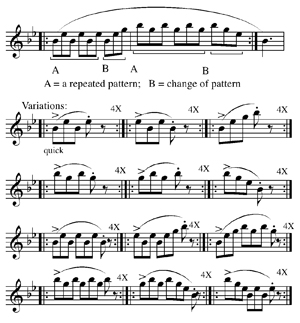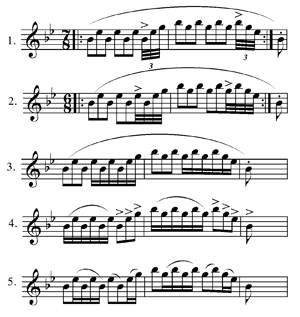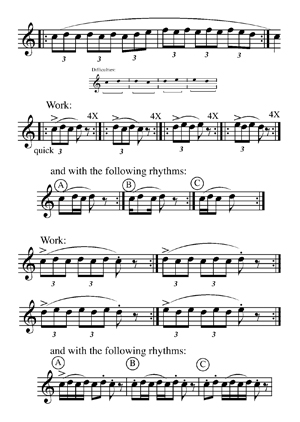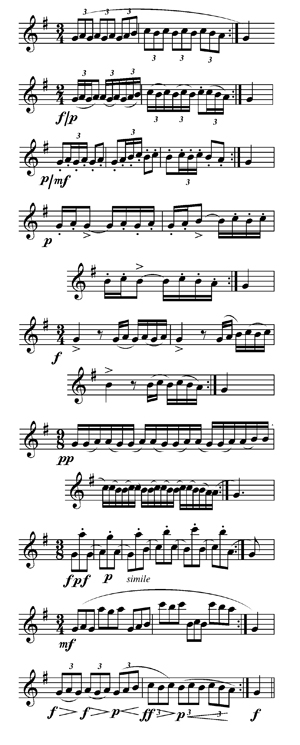Raymond Guiot taught his students how to get the most out of the Moyse scale collection, 480 Gammes et Arpèges. Guiot’s insights on practice technique were so clever that all his students were able to master Moyse’s book in record time.
Learning and memorizing all the scales and arpeggios is of the utmost importance because most music is based on them. Guiot’s practice methods, much like Moyse’s, rely on challenging variations for developing finger technique, legato-playing, good articulation, and smooth intervals with uncompromised concentration. His methods have stayed with me and have allowed me to confidently master pages and pages of technical exercises, etudes, and repertoire.
Practicing with Variations
When working with Gammes et arpèges, Guiot insisted on practice with variations based on repetition of patterns to gain confidence on difficult finger combinations as shown below.

He focused on variations that stress pattern changes – the place where our fingers usually fail:

He also encouraged us to isolate difficult note combinations and practice them over and over:

Applying Theory Knowledge
Don’t cheat. When practicing technique use real fingerings if you want to develop finger independance. Analyze! Know which scale or chord you are playing. Memorizing the harmonic language as applied to the flute develops our technical ability and sight reading at the same time.
The more familiar flutists are with scales and arpeggios, the less time they have to spend practicing passage work in solo repertoire. Technical difficulties that are encountered daily and practiced intelligently become much easier. Doing technical homework gives flutists the ability to play a Stravinsky ballet one week, a Shostakovich symphony the next, and a flute and piano recital in between. Professional musicians simply do not have six months to prepare for a concert. If you haven’t practiced scales and arpeggios on a daily basis, start now to get these technical tools in your bag.
Not Just the Fingers
Guiot always reminded us that finger practice should be done with perfect rhythm, good breathing, posture, and tone. Always caress the mechanism, aiming to phrase the exercises musically, with perfect legato, or lively articulation
As Guiot was quick to point out, fingers are not a separate entity. Technique practice should encompass all aspects of flute playing, such as fingers, embouchure, breathing, sound, posture, and articulation, as well as all aspects of music-making including rhythm, phrasing, accentuation, legato, nuances, and colors.
It is of no use to play a rapid sequence of notes with a lousy sound, or to play with a gorgeous sound and sloppy fingers. I will always remember one rainy afternoon in Paris when I took Boehm’s Grand Polonaise to a lesson with Guiot. When he played the rapid notes in the introduction for me, I understood. Needless to say, his fingers were amazingly precise, but there was something else to it: his sound was beautiful, and he shaped the scales the way a soprano would sing them – not mechanically, not coldly, but magically expressive.
Daily Practice Suggestions
Below is a list of what you should practice every day:
•Major and minor scales
•Major and minor scales in thirds
•Major and minor scales in fourths
•Major, minor and diminished arpeggios
•Broken major, minor and diminished arpeggios
•Diminished, half-diminished, minor, dominant, major arpeggios of sevenths
•Broken diminished, half-diminished, minor, dominant, major arpeggios of sevenths
You should also practice chromatic scales and trill exercises as found in Taffanel-Gaubert’s Daily Exercises, Reichert’s 7 Daily Etudes, and Boehm’s 12 Etudes Op. 15.
When practicing the daily “technical menu” described above, listening very carefully as you play will reveal things that you cannot do at your best. Don’t ignore them: create variations to help you address and solve every problem you encounter. The idea is to improve little by little every day.
Some more ideas for variations on Moyse’s 480 Gammes et Arpèges are in the following box. There are an unlimited number of possible variations.

Create new ones and challenge yourself. You should also apply this method of practicing to etudes, orchestral parts and repertoire!
The flute is only an instrument with which to make music. We must never get caught up with the idea that playing this instrument technically perfect is enough. Therefore perfection of the exercises is not an end. Play the exercises to master the language that enables us to communicate clearly the special message of a musical work through the instrument. Audiences want to be overwhelmed by the music, not by technical prowess. Certainly in the practice room you should search for progress and avoid mistakes, but in performance, the ultimate goal is to share and communicate with an audience, taking all risks necessary to create a magic, special moment.






